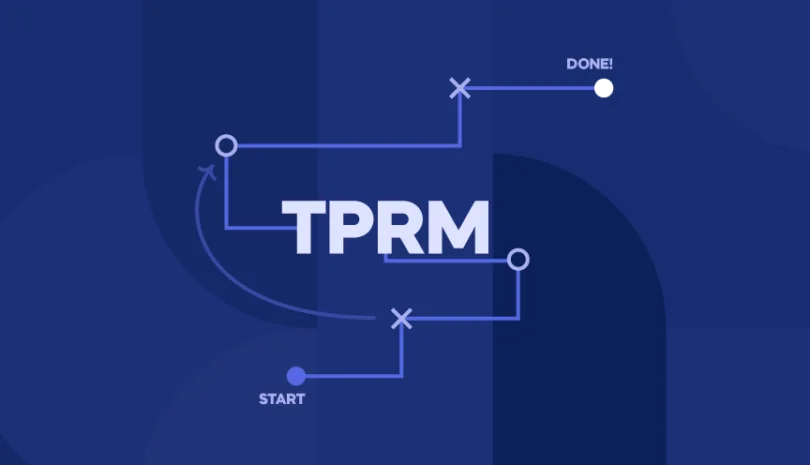Today’s digital supply chain faces an unprecendented risk of ransomware attacks, data breaches, and other security incidents more than ever before due to several factors. First, its growing complexity and reliance on third, fourth, and n-th parties makes visibility difficult, to say the least. Second, organizations have IT systems and networks that are inherently dynamic due to changing user needs, security considerations, and technical complexity and interdependence. All of these factors demand that organizations quickly adapt to these changes.
Finally, as organizations embrace technological advancement such as cloud services, AI, and machine learning, they struggle to implement TPRM services that are efficient, accurate, and scalable for their IT and risk management teams. Incorporating both AI and automation in their third-party risk management enables organizations to effectively navigate technological advancements and struggles while at the same time strengthening their digital supply chain resilience.
Challenges in Traditional TPRM Services
Traditional TPRM services face a number of challenges, including time-consuming manual risk assessments that are prone to error, difficulty managing vast amounts of vendor data, and limited ability to continuously monitor third-party activities and risks.
Other challenges include:
- Lack of visibility into the supply chain. The increasing complexity of supply chains, the evolution of third-party risk, many organizations aren’t even aware of which vendors, service providers, and contractors have access to your sensitive data and/or critical systems. That means they aren’t able to take the first step in evaluating third-party risk.
- Inaccurate risk categorization and prioritization. Even when they do successfully identify the vendors and third parties that exist in their supply chain, many organizations lack the ability to determine the criticality of these third parties and the level of risk they present to the organization. Without a system in place to prioritize risk, an organization is unable to accurately determine where to focus its mitigation and cybersecurity efforts.
- Inability to adhere to evolving regulatory compliance. Measuring and monitoring third-party risk is an essential component of many industrial regulations such as PCI-DSS, HIPAA, and GDPR. Non-compliance with relevant industry regulations can lead to monetary penalties, a loss of customer trust, and an increased risk of data breaches and cybersecurity attacks.
How AI Enhances TPRM Services
These challenges are a direct result of the overwhelming amount of data organizations must gather and analyze to accurately evaluate their third-party risk. Since AI has the ability to gather and analyze large amounts of data, it is now being integrated into many components of an organization’s third-party risk management.
This includes:
- Automated risk assessments
- Predictive analytics
- Continuous monitoring
Automated Risk Assessments
Automated processes driven by AI can map the digital supply chain, allowing it to then quickly identify vulnerabilities present and how they should be prioritized. It can sift through hundreds of data points quickly, delivering real-time updates that evaluate third-party vendor risk more accurately. It can also help facilitate a faster response time to vendor risk assessments through AI-powered completion of questionnaires and verification of responses using a combination of public information, valid and relevant vendor documents, and vendor risk assessments. They can also do this continuously, adjusting vendor risk assessments with real-time updates based on dynamic vendor risk profiles.
Predictive Analytics
AI helps organizations to enhance their TPRM services by enabling them to take a proactive approach to risk management. Since it quickly detects patterns and anomalous behavior from rapid data analysis, it is a crucial technology in threat intelligence and predictive modeling. For example, using historical data, AI may be able to predict where a data breach might occur along your supply chain. Some researchers even feel AI can help them predict Black Swan events with greater accuracy, effectively turning them into “Grey Swan Events.” For example, it might be able to predict sudden changes in market conditions and their effect on the supply chain, enabling organizations to adapt proactively, both avoiding a loss in revenue and damage to the brand.
Continuous Monitoring
Finally, AI helps organizations monitor their systems and networks continuously to identify anomalous customer behavior at the first sign of a possible threat. It then sends automated alerts and notifications to your incident response team so that it can take the immediate necessary actions to mitigate against the threat and defend against an attack. Continuous monitoring is especially critical for managing third-party risks with today’s increasingly complex and dynamic digital supply chain and evolving cybersecurity and regulatory landscape.
The Role of Automation in Streamlining TPRM Services
Since traditional TPRM includes manual workflows, automating TPRM services tend to transform these workflows into AI-automated ones. This not only eliminates human error, increasing efficiency and saving time and resources, but also enables the scalability of new vendors by making due diligence, onboarding, and audit and compliance management more effective.
Automated Due Diligence and Onboarding
The automation of AI workflows can more quickly and effectively analyze network traffic and detect suspicious behavior to assess risk related to potential new vendors. It can collect data about third parties to complete risk assessments such as past history fraud, financial misdemeanors or recent scandals, to understand whether they meet compliance or are listed on sanctions list and pose a high level of threat to your organization as new vendors. All of these workflows together facilitate more effective and scaling of vendor onboarding, or a decision to replace the vendor with one that exposes them to significantly less risk.
Workflow Automation
Workflow automation helps streamline TPRM by eliminating manual tasks, fostering teamwork, and prioritizing risk according to each company’s risk appetite. For example, after receiving a cybersecurity questionnaire by a third party, your IT or risk management team can use it to ask specific stakeholders for review. It also eliminates manual tasks and the back-and-forth between your organization and third parties by creating step-by-step remediation tasks that can automatically be applied by your third party. Finally, workflows can be set to automatically approve third parties with cyber risk ratings greater than 80 that pose no critical risk to your organization. Alternatively, risk management and IT teams could generate remediation steps for third parties with a cyber risk rating less than 80 that do pose a critical risk to your organization.
Audit and Compliance Automation
Since audit requirements have become more demanding as a response to the complex regulatory landscape, AI-driven automation has become a valuable tool for organizations to continuously monitor vendors and enforce compliance standards consistently. For example, workflow automations help ensure that any changes in third-party ratings and emerging cyber vulnerabilities are automatically reflected in your evaluation process to align with the latest regulations and standards relevant to your organization. Automation of compliance also decreases the cost of compliance by decreasing the hours the IT or security team previously spent on checking for compliance manually. It also reduces the potential for human error, contributing to more accurate and reliable third-party audits.
Benefits of Integrating AI and Automation in TPRM Services
The integration of AI and automation in TPRM services strengthens both supply chain and third-party resilience by delivering greater visibility into your third, fourth, and n-th party services.
Other benefits include:
- Increased efficiency and speed
- Greater accuracy and reduced human error
- Scalability
- Improved regulatory compliance
Increased Efficiency and Speed
An advanced TPRM service such as Panorays can deliver faster vendor risk assessments using
a combination of AI-generated answers and AI-powered verification that searches through information from previous similar assessments and internal vendor documents. Automated TPRM workflows of both external and internal risk assessments allow it to continuously monitor vendor attack surfaces for vulnerabilities. Once these vulnerabilities are revealed, automating the remediation steps required to close security gaps actions also enable organizations to respond more quickly in the event of an attack or security incident. The automation of key workflows in third-party risk management simplify traditionally complex manual tasks while minimizing the chance of errors.
Enhanced Accuracy and Reduced Human Error
With its ability to analyze massive amounts of data quickly, AI-driven vendor assessments offer more accuracy than the traditional manual vendor assessments. Automated and customized cybersecurity questionnaires streamline the work involved in developing these questionnaires, targeting questions that apply only to the specific third party and take into consideration the business context and level of risk it potentially presents. AI also enhances real-time threat detection, allowing for continuous monitoring and analysis of behavioral patterns of users to detect evolving threats before they become major incidents, with fewer false positives and false negatives.
Scalability
As organizations increasingly rely on third parties for outsourcing critical services such as data management and cloud services, they need to be able to manage and monitor third party risks. Since traditional vendor assessments are manual and rely on frequent third-party vendor communication, they are often difficult to scale to meet this growing demand. AI and automation enable organizations to manage and monitor increasing numbers of third-party vendors effectively while not having to scale their human resources.
Improved Regulatory Compliance
Since regulations and standards are continually evolving and updated to address the latest technological, cybersecurity, and global market trends, organizations must regularly evaluate their third-party vendors to verify compliance. For organizations relying on traditional manual audits, AI and automation reduce the time and resources necessary to continually verify third-party compliance with the latest regulations. Integrating AI and automation into your TPRM systems can quickly and regulatory analyze your vendor’s security policies, compliance certificates, and contracts to verify vendor compliance – even conducting these audits remotely. With ongoing compliance monitoring, you can also track your vendor’s activities and send real-time alerts to the earliest signs of non-compliance of specific regulations such as GDPR, HIPAA, and NIST.
Optimizing TPRM Services with AI and Automation
A recent Panorays survey reports that 61% of CISOs believe AI could prevent more than 50% of third-party breaches, and 70% believe the automation of third-party assessment to be either an important or very important capability of their TPRM service. As more organizations adapt AI and automation into their TPRM services, however, they are quickly finding additional use cases of each for effective third-party risk management. Organizations that want to strengthen their security posture and defend against evolving threats cannot afford to hesitate integrating these same services.
Panorays’ third-party cyber risk management platform integrates AI and automation in its TPRM services with features like:
- AI-powered vendor risk assessments that help you predict the probability of a third-party data breach.
- Continuous supply chain monitoring that detects hidden 3rd-Nth parties and maps them out according to level of criticality.
- Automated remediation that sends a customized plan to third-party vendors according to each organization’s specific risk appetite.
- Ongoing compliance monitoring to ensure organizations adhere to evolving regulations and standards related to third-party risk management.
- Dynamic Risk DNA scores that generate the most accurate, comprehensive third-party risk profiles.
Want to learn more about how Panorays integrates AI and automation in its TPRM services? Get a demo of our third-party cyber risk management platform today.
AI and Automation in Optimizing TPRM Processes FAQs
-
Yes, TPRM services can help with compliance audits by offering comprehensive risk assessment, documenting and reporting, the evaluation of internal policies and security controls related to third party relationships, and ongoing monitoring for a proactive approach to third-party risk management. All of these services help organizations ensure that they align with the latest regulations and standards relevant to their industry.
-
While many TPRM services offer vendor risk scoring, only advanced third-party cyber risk management services deliver a customized risk assessment and risk scoring that takes into account the evolving business context of your organization’s relationship with its third parties. This is done by mapping the supply chain that assesses third-party risk according to its level of criticality.
-
The time frame involved in implementing a TPRM service depends on a variety of factors, including the organization’s size, complexity of its supply chain, whether it has an existing risk management framework, and the available time and resources of its IT team. Based on these different factors, implementation could take anywhere from a few months to over a year.
-
TPRM services typically integrate with existing security tools or processes, such as SIEM, threat intelligence, incident response planning, continuous monitoring, and automated security assessments. In addition, they can integrate into existing cybersecurity frameworks, organizational and risk management processes. All of these integrations help ensure that an organization enhances its management of vendor-related risks without disrupting existing workflows.



